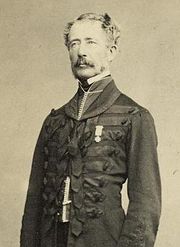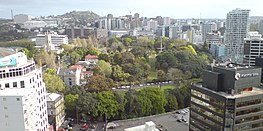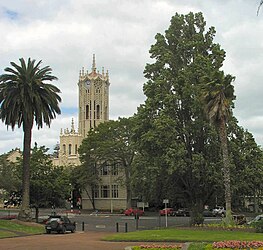The New Zealand Defence Force is the three-branched military of New Zealand. The NZDF is responsible for the protection of the national security of New Zealand and its realm, promoting its interests, safeguarding peace and security, as well as supporting peacekeeping and humanitarian missions. It consists of three services: the Royal New Zealand Navy (RNZN), the New Zealand Army and the Royal New Zealand Air Force (RNZAF), as well as tri-service components. As of June 2024, the NZDF has a strength of 15,383 employees, consisting of 10,037 regular force personnel, 3,281 reserve force personnel and 3,294 civilian members. It is supported by the New Zealand Ministry of Defence (MOD) and is commanded by the Chief of Defence Force (CDF).

The New Zealand Wars took place from 1845 to 1872 between the New Zealand colonial government and allied Māori on one side, and Māori and Māori-allied settlers on the other. Though the wars were initially localised conflicts triggered by tensions over disputed land purchases, they escalated dramatically from 1860 as the government became convinced it was facing united Māori resistance to further land sales and a refusal to acknowledge Crown sovereignty. The colonial government summoned thousands of British troops to mount major campaigns to overpower the Kīngitanga movement and also conquest of farming and residential land for British settlers. Later campaigns were aimed at quashing the Pai Mārire religious and political movement, which was strongly opposed to the conquest of Māori land and eager to strengthen Māori identity. Māori religious movements that promoted pan-Māori identity played a major role in the Wars.
The First Taranaki War was an armed conflict over land ownership and sovereignty that took place between Māori and the Colony of New Zealand in the Taranaki region of New Zealand's North Island from March 1860 to March 1861.
The Second Taranaki War is a term used by some historians for the period of hostilities between Māori and the New Zealand Government in the Taranaki district of New Zealand between 1863 and 1866. The term is avoided by some historians, who either describe the conflicts as merely a series of West Coast campaigns that took place between the Taranaki War (1860–1861) and Titokowaru's War (1868–69), or an extension of the First Taranaki War.

The invasion of the Waikato became the largest and most important campaign of the 19th-century New Zealand Wars. Hostilities took place in the North Island of New Zealand between the military forces of the colonial government and a federation of Māori tribes known as the Kingitanga Movement. The Waikato is a territorial region with a northern boundary somewhat south of the present-day city of Auckland. The campaign lasted for nine months, from July 1863 to April 1864. The invasion was aimed at crushing Kingite power and also at driving Waikato Māori from their territory in readiness for occupation and settlement by European colonists. The campaign was fought by a peak of about 14,000 Imperial and colonial troops and about 4,000 Māori warriors drawn from more than half the major North Island tribal groups.
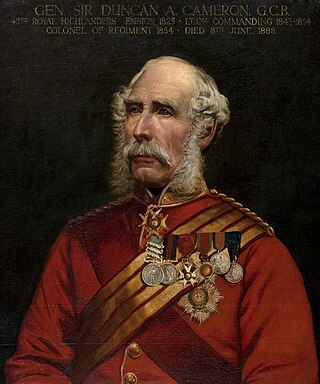
General Sir Duncan Alexander Cameron, was a British Army officer who fought in the Crimean War and part of the New Zealand Wars. He was later a governor of the Royal Military College, Sandhurst.
The Defence of Pukekohe East was an action during the Invasion of the Waikato, part of the New Zealand Wars. On 13 September and 14 September 1863, 11 settlers and 6 militia men inside a half-completed stockade around the Pukekohe East church held off a Māori taua or war party of approximately 200 men from Ngāti Maniapoto and Ngāti Pou iwi, until they were relieved by detachments of the 18th, 65th and 70th Regiments. In a series of actions around the stockade the taua sustained 20% casualties and retreated.

Kūpapa were Māori who fought on the British side in the New Zealand Wars of the 19th century.
The 65th Regiment of Foot was an infantry regiment of the British Army, raised in 1756 as the 2nd Battalion, 12th Regiment of Foot. Under the Childers Reforms it amalgamated with the 84th Regiment of Foot to become the 1st Battalion, York and Lancaster Regiment in 1881.
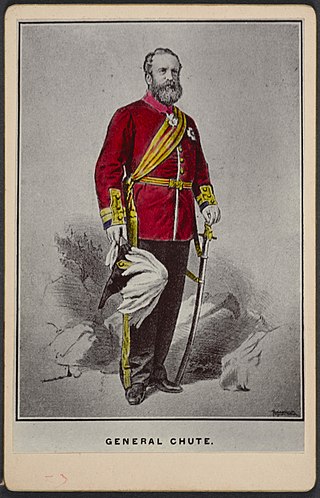
General Sir Trevor Chute, was an Irish-born officer who served in the British Army during the Victorian era.
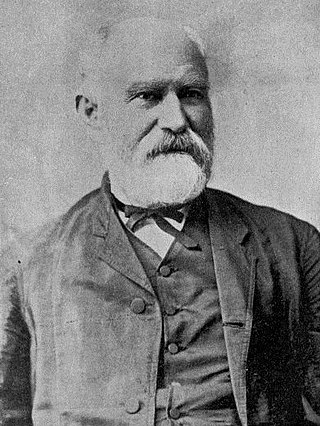
Theodore Minet Haultain was a 19th-century New Zealand politician and Minister of Colonial Defence (1865–69). He came to New Zealand as a soldier and farmed in south Auckland.
The Royal New Zealand Fencible Corps was formed in 1846, following the conclusion of the Northern War phase of the New Zealand Wars against Hone Heke. The Governor, George Grey, had requested military forces for the defence of the early settlers in New Zealand, and instead of supplying regular military forces the British parliament approved the creation of the Corps. Auckland, which had a population of 2,800 at the time, virtually doubled in size when the fencibles and their families disembarked.
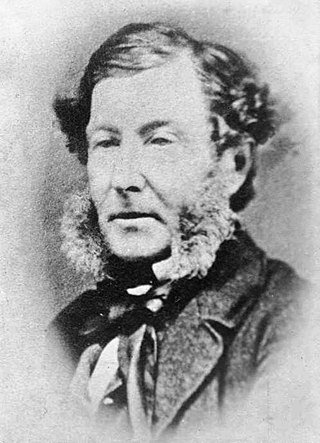
Marmaduke George Nixon was a soldier in the New Zealand Wars. Born at Malta, he joined the British Army in 1831, spending most of his career as an officer in British India with the 39th Regiment of Foot. He left the British Army in 1851 and shortly afterwards emigrated to New Zealand to take up farming in South Auckland. In 1860, during one of the main phases of the New Zealand Wars, he formed and led a cavalry unit in defence of South Auckland. He later participated in the Invasion of the Waikato as commander of Nixon's Horse, another cavalry unit. He was one of the highest ranking casualties of the New Zealand Wars when he died on 27 May 1864 from wounds received in an attack earlier in the year on a village at Rangiaowhia. He was also a Member of Parliament, representing the largely rural electorate of Franklin from 1861 up until his death.

Lieutenant General Charles Emilius Gold was an English officer of the 65th Regiment, British Army, and artist of historic importance but limited ability. He was born at Woolwich Common, Kent, England, on 6 January 1809 and obtained a commission in the 65th Regiment by purchase on 28 March 1828.
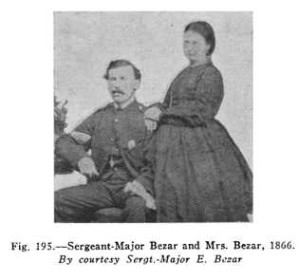
Sergeant Major Edwin Bezar was an English soldier and author who fought in the Crimean War, counterinsurgency in the Aden Settlement and the New Zealand Wars. At his death in 1936 aged 97 he was the last surviving soldier of the 57th Regiment that had fought in the New Zealand Wars; he may have been the war's last surviving combatant but this is impossible to confirm due to incomplete records. In retirement he was an active public servant for the New Zealand Defence Department, including organising the first Maori Rifle Corps of Volunteers in the 1870s. He was a prolific correspondent and wrote an account of his experiences in the New Zealand Wars.
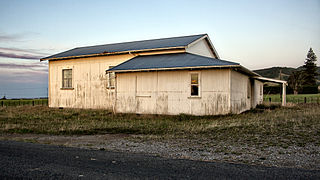
Tataraimaka is a rural coastal area in Taranaki, New Zealand. It is predominantly a dairy farming area, approximately 20 kilometres (12 mi) south-west of New Plymouth. Tataraimaka is located south of Ōakura and north of Ōkato. The Timaru River passes through Tataraimaka on its way from Mount Taranaki. The area lies close to the Kaitake ranges at the foot of mount Taranaki, and consists of steep farmlands which overlook rolling pastures, intercepted by many creeks and rivers leading to the rocky, west coast shoreline. The area is well known for its beaches. Weld Road Beach is a popular surf beach with the locals. The area is becoming increasingly popular for people building lifestyle properties. There are many hiking tracks available to the public which traverse the Kaitake Range. One of these treks is the Boars Head Mine track, which takes hikers to a historical gold mine.

Queen's Redoubt is a fortification of the New Zealand Wars, located at Pōkeno, New Zealand. It was built to protect the southern end of a major supply route to Auckland. It subsequently served as the main British base during the early stages of the Invasion of the Waikato. Erected in June 1862, it was garrisoned until 1866 at which time it was abandoned. The majority of the site is now owned by the Queen’s Redoubt Trust, which has developed it as a visitor attraction.
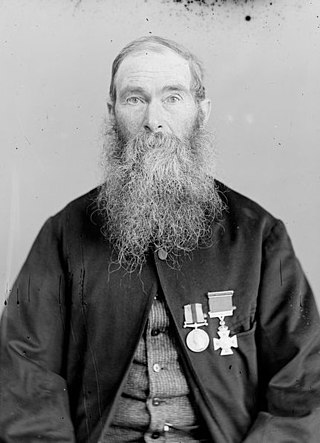
Samuel Austin was an Irishman who served with the British Army and the New Zealand colonial militia. He was a recipient of one of the world's rarest gallantry decorations, the New Zealand Cross.

The Taranaki Regiment was a territorial infantry regiment of the New Zealand Military Forces. The regiment traced its origins to the Taranaki Volunteer Rifle Company, a volunteer corps formed in 1858 and which saw service in the New Zealand Wars. The volunteer corps also provided men to the New Zealand contingents sent to South Africa during the Second Boer War and in 1911 became the 11th Regiment (Taranaki Rifles). During the First World War, the regiment provided a company to each of the battalions of the Wellington Infantry Regiment and saw combat at Galipolli and on the Western Front. After the war the regiment was renamed the Taranaki Regiment and remained in New Zealand for home defense during the Second World War. Men from the regiment, however, served with the 19th, 22nd, 25th and 36th Battalions of the Second New Zealand Expeditionary Force. In 1948, the Taranaki Regiment was amalgamated with the Wellington West Coast Regiment and became the Wellington West Coast and Taranaki Regiment.
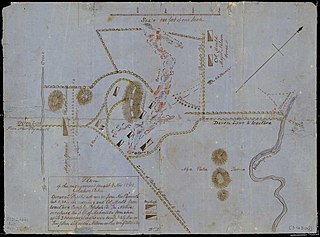
The Battle of Mahoetahi was fought as part of the First Taranaki War. In November 1860 a small force of around 150 Ngāti Hauā warriors travelled to Taranaki from the Waikato and challenged the British to battle at Mahoetahi, near New Plymouth. The British replied with a much larger force of British Army regulars and New Zealand colonial units and effectively encircled and defeated the Ngāti Hauā force.




